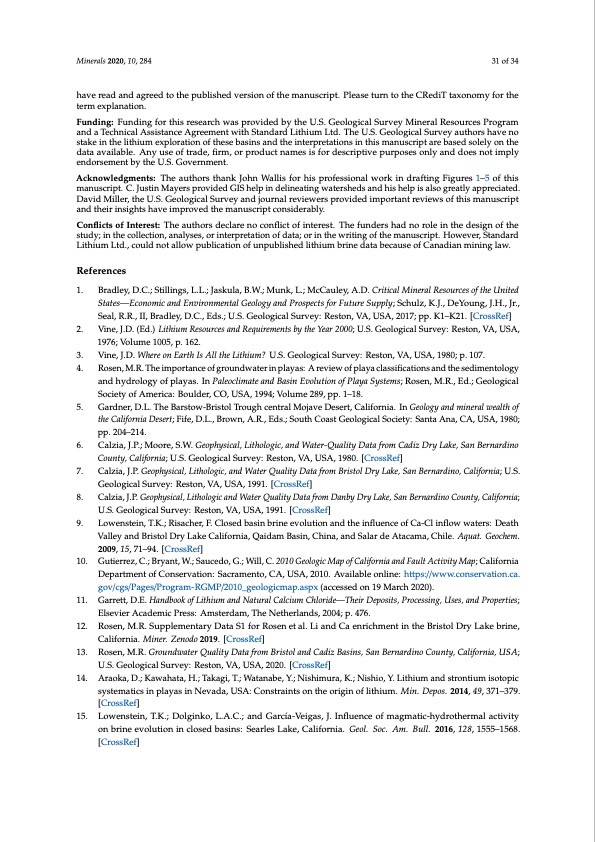
PDF Publication Title:
Text from PDF Page: 031
Minerals 2020, 10, 284 31 of 34 have read and agreed to the published version of the manuscript. Please turn to the CRediT taxonomy for the term explanation. Funding: Funding for this research was provided by the U.S. Geological Survey Mineral Resources Program and a Technical Assistance Agreement with Standard Lithium Ltd. The U.S. Geological Survey authors have no stake in the lithium exploration of these basins and the interpretations in this manuscript are based solely on the data available. Any use of trade, firm, or product names is for descriptive purposes only and does not imply endorsement by the U.S. Government. Acknowledgments: The authors thank John Wallis for his professional work in drafting Figures 1–5 of this manuscript. C. Justin Mayers provided GIS help in delineating watersheds and his help is also greatly appreciated. David Miller, the U.S. Geological Survey and journal reviewers provided important reviews of this manuscript and their insights have improved the manuscript considerably. Conflicts of Interest: The authors declare no conflict of interest. The funders had no role in the design of the study; in the collection, analyses, or interpretation of data; or in the writing of the manuscript. However, Standard Lithium Ltd., could not allow publication of unpublished lithium brine data because of Canadian mining law. References 1. Bradley, D.C.; Stillings, L.L.; Jaskula, B.W.; Munk, L.; McCauley, A.D. Critical Mineral Resources of the United States—Economic and Environmental Geology and Prospects for Future Supply; Schulz, K.J., DeYoung, J.H., Jr., Seal, R.R., II, Bradley, D.C., Eds.; U.S. Geological Survey: Reston, VA, USA, 2017; pp. K1–K21. [CrossRef] 2. Vine, J.D. (Ed.) Lithium Resources and Requirements by the Year 2000; U.S. Geological Survey: Reston, VA, USA, 1976; Volume 1005, p. 162. 3. Vine, J.D. Where on Earth Is All the Lithium? U.S. Geological Survey: Reston, VA, USA, 1980; p. 107. 4. Rosen, M.R. The importance of groundwater in playas: A review of playa classifications and the sedimentology and hydrology of playas. In Paleoclimate and Basin Evolution of Playa Systems; Rosen, M.R., Ed.; Geological Society of America: Boulder, CO, USA, 1994; Volume 289, pp. 1–18. 5. Gardner, D.L. The Barstow-Bristol Trough central Mojave Desert, California. In Geology and mineral wealth of the California Desert; Fife, D.L., Brown, A.R., Eds.; South Coast Geological Society: Santa Ana, CA, USA, 1980; pp. 204–214. 6. Calzia, J.P.; Moore, S.W. Geophysical, Lithologic, and Water-Quality Data from Cadiz Dry Lake, San Bernardino County, California; U.S. Geological Survey: Reston, VA, USA, 1980. [CrossRef] 7. Calzia, J.P. Geophysical, Lithologic, and Water Quality Data from Bristol Dry Lake, San Bernardino, California; U.S. Geological Survey: Reston, VA, USA, 1991. [CrossRef] 8. Calzia, J.P. Geophysical, Lithologic and Water Quality Data from Danby Dry Lake, San Bernardino County, California; U.S. Geological Survey: Reston, VA, USA, 1991. [CrossRef] 9. Lowenstein, T.K.; Risacher, F. Closed basin brine evolution and the influence of Ca-Cl inflow waters: Death Valley and Bristol Dry Lake California, Qaidam Basin, China, and Salar de Atacama, Chile. Aquat. Geochem. 2009, 15, 71–94. [CrossRef] 10. Gutierrez, C.; Bryant, W.; Saucedo, G.; Will, C. 2010 Geologic Map of California and Fault Activity Map; California Department of Conservation: Sacramento, CA, USA, 2010. Available online: https://www.conservation.ca. gov/cgs/Pages/Program-RGMP/2010_geologicmap.aspx (accessed on 19 March 2020). 11. Garrett, D.E. Handbook of Lithium and Natural Calcium Chloride—Their Deposits, Processing, Uses, and Properties; Elsevier Academic Press: Amsterdam, The Netherlands, 2004; p. 476. 12. Rosen, M.R. Supplementary Data S1 for Rosen et al. Li and Ca enrichment in the Bristol Dry Lake brine, California. Miner. Zenodo 2019. [CrossRef] 13. Rosen, M.R. Groundwater Quality Data from Bristol and Cadiz Basins, San Bernardino County, California, USA; U.S. Geological Survey: Reston, VA, USA, 2020. [CrossRef] 14. Araoka, D.; Kawahata, H.; Takagi, T.; Watanabe, Y.; Nishimura, K.; Nishio, Y. Lithium and strontium isotopic systematics in playas in Nevada, USA: Constraints on the origin of lithium. Min. Depos. 2014, 49, 371–379. [CrossRef] 15. Lowenstein, T.K.; Dolginko, L.A.C.; and García-Veigas, J. Influence of magmatic-hydrothermal activity on brine evolution in closed basins: Searles Lake, California. Geol. Soc. Am. Bull. 2016, 128, 1555–1568. [CrossRef]PDF Image | Bristol Dry Lake Brine Compared to Brines from Cadiz

PDF Search Title:
Bristol Dry Lake Brine Compared to Brines from CadizOriginal File Name Searched:
minerals-10-00284-v2.pdfDIY PDF Search: Google It | Yahoo | Bing
Product and Development Focus for Infinity Turbine
ORC Waste Heat Turbine and ORC System Build Plans: All turbine plans are $10,000 each. This allows you to build a system and then consider licensing for production after you have completed and tested a unit.Redox Flow Battery Technology: With the advent of the new USA tax credits for producing and selling batteries ($35/kW) we are focussing on a simple flow battery using shipping containers as the modular electrolyte storage units with tax credits up to $140,000 per system. Our main focus is on the salt battery. This battery can be used for both thermal and electrical storage applications. We call it the Cogeneration Battery or Cogen Battery. One project is converting salt (brine) based water conditioners to simultaneously produce power. In addition, there are many opportunities to extract Lithium from brine (salt lakes, groundwater, and producer water).Salt water or brine are huge sources for lithium. Most of the worlds lithium is acquired from a brine source. It's even in seawater in a low concentration. Brine is also a byproduct of huge powerplants, which can now use that as an electrolyte and a huge flow battery (which allows storage at the source).We welcome any business and equipment inquiries, as well as licensing our turbines for manufacturing.| CONTACT TEL: 608-238-6001 Email: greg@infinityturbine.com | RSS | AMP |